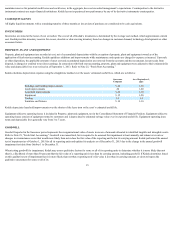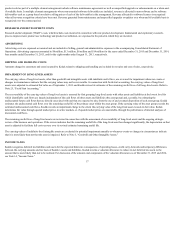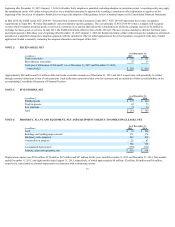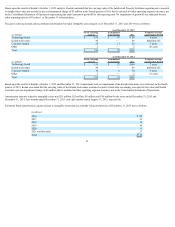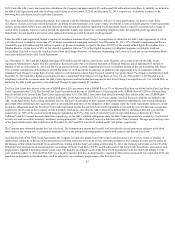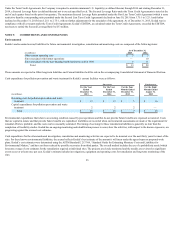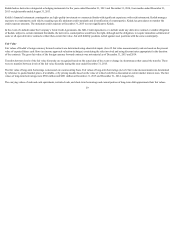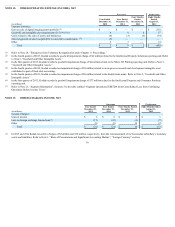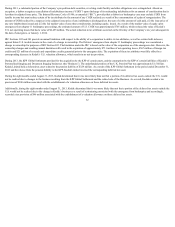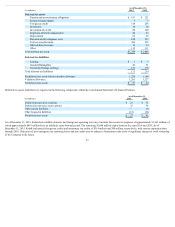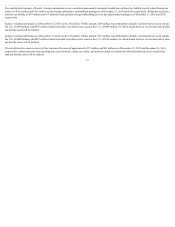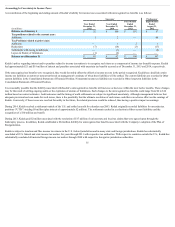Kodak 2015 Annual Report Download - page 26
Download and view the complete annual report
Please find page 26 of the 2015 Kodak annual report below. You can navigate through the pages in the report by either clicking on the pages listed below, or by using the keyword search tool below to find specific information within the annual report.
Under the Term Credit Agreements, the Company is required to maintain minimum U.S. Liquidity (as defined therein) through 2014 and starting December 31,
2014, a Secured Leverage Ratio (as defined therein) not to exceed specified levels. The Secured Leverage Ratio under the Term Credit Agreements is tested at the
end of each quarter based on the prior four quarters, The maximum Secured Leverage Ratio permitted under the First Lien Term Credit Agreement (which is more
restrictive than the corresponding ratio permitted under the Second Lien Term Credit Agreement) declined on June 30, 2015 from 3.75:1 to 3.25:1 and further
declined on December 31, 2015 from 3.25:1 to 2.75:1, with no further adjustments for the remainder of the agreement. As of December 31, 2015, Kodak was in
compliance with all covenants under the Term Credit Agreements. Kodak’s EBITDA, as calculated under the Term Credit Agreements, exceeded the EBITDA
necessary to satisfy the Secured Leverage Ratio by $33 million.
NOTE 9: COMMITMENTS AND CONTINGENCIES
Environmental
Kodak’s undiscounted accrued liabilities for future environmental investigation, remediation and monitoring costs are composed of the following items:
As of December 31,
(in millions) 2015 2014
Other current operating sites $ 7 $ 7
Sites associated with former operations — 10
Sites associated with the non-imaging health businesses sold in 1994 6 11
Total $ 13 $ 28
These amounts are reported in Other long-term liabilities and Current liabilities held for sale in the accompanying Consolidated Statement of Financial Position.
Cash expenditures for pollution prevention and waste treatment for Kodak’s current facilities were as follows:
Successor Predecessor
(in millions)
For the Year
Ended
December 31,
2015
For the Year
Ended
December 31,
2014
For the Four
Months Ended
December 31,
2013
For the Eight
Months Ended
August 31,
2013
Recurring costs for pollution prevention and waste
treatment $ 13 $ 13 $ 5 $ 16
Capital expenditures for pollution prevention and waste
treatment 2 2 2 —
Total $ 15 $ 15 $ 7 $ 16
Environmental expenditures that relate to an existing condition caused by past operations and that do not provide future benefits are expensed as incurred. Costs
that are capital in nature and that provide future benefits are capitalized. Liabilities are recorded when environmental assessments are made or the requirement for
remedial efforts is probable, and the costs can be reasonably estimated. The timing of accruing for these remediation liabilities is generally no later than the
completion of feasibility studies. Kodak has an ongoing monitoring and identification process to assess how the activities, with respect to the known exposures, are
progressing against the accrued cost estimates.
Cash expenditures for the aforementioned investigation, remediation and monitoring activities are expected to be incurred over the next thirty years for most of the
sites. For these known environmental liabilities, the accrual reflects Kodak’s best estimate of the amount it will incur under the agreed-upon or proposed work
plans. Kodak’s cost estimates were determined using the ASTM Standard E 2137-06, “Standard Guide for Estimating Monetary Costs and Liabilities for
Environmental Matters,” and have not been reduced by possible recoveries from third parties. The overall method includes the use of a probabilistic model which
forecasts a range of cost estimates for the remediation required at individual sites. The projects are closely monitored and the models are reviewed as significant
events occur or at least once per year. Kodak’s estimate includes investigations, equipment and operating costs for remediation and long-term monitoring of the
sites.
25


